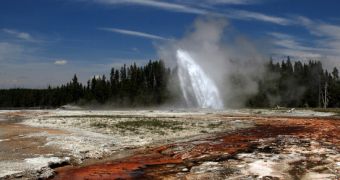The magma reservoir under the Yellowstone National Park in the US is roughly two and a half times bigger than initially estimated, researcher Jamie Farrell with the University of Utah says.
Speaking at a meeting of the Geological Society of America in Denver, Colorado, this past October 27, the specialist detailed that, according to recent investigations, this reservoir measures about 80 kilometers (almost 50 miles) in length and 20 kilometers (roughly 12.5 miles) in width.
What's more, he argued that it would not be that far-fetched if someone were to compare it to a 4,000-cubic-kilometer sponge (959.6-cubic-mile), 6-8% of which is filled with molten rock, Nature reports.
“I don’t know of any other magma body that’s been imaged that’s that big,” the specialist reportedly told the people present at the conference.
Jamie Farrell and his colleagues reached the conclusion that the magma reservoir that lies under Yellowstone is considerably bigger than previously assumed after analyzing data collected with the help of seismometers.
More precisely, the researchers looked at how seismic waves generated by over 4,500 different earthquakes traveled through the underground in this part of the US.
Since seismic waves behave different when traveling through molten rock than they do when traveling through solid structures, this information allowed Jamie Farrell and his fellow researchers to determine the limits of the molten rock reservoir with a high degree of accuracy.
Despite the fact that Yellowstone National Park's underground magma reservoir is as big as it is, Jamie Farrell says that what geologists and ordinary folks should be worried about is not a major eruption but a powerful earthquake.
This is because the crust that caps this underground molten rock blob is by no means sturdy and could easily fracture during shakes whose magnitude is at least 7.
As explained by Nature, “This area of the western United States is being stretched and thinned by geological forces, causing the crust to fracture in large quakes.” Furthermore, “The risk of more of these quakes occurring remains high, says Smith, making them a much bigger problem than any chance of a mammoth eruption.”

 14 DAY TRIAL //
14 DAY TRIAL //